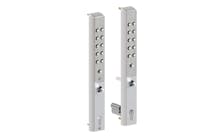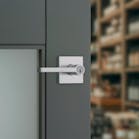Oct. 23--Entry-door locks have entered the digital age, but the key to safety still is a basic component.
"You have to have a good deadbolt on all exterior doors," says Rick South, owner of the Burglar's Nightmare locksmith in Greensburg.
Krista Weigand from the California-based Kwikset lock company agrees "deadbolts are where the security is."
Sgt. Kevin Gasiorowski from the Pittsburgh police burglary division says "the more locks the better," specifying deadbolts are the most important part of that array.
But the use and deployment of a homeowner's trusted friend has become inter-connected with the Internet and other electronic devices. Both Kwikset and Indiana-based Schlage offer systems in which locks can be opened or secured from a computer or mobile device.
They also offer systems that will tell you whether a lock is being used, letting a parent know perhaps whether a son or daughter is home on time.
But high-tech or low, such features all center on the security provided by a good deadbolt. But safety experts agree that sliding shaft of metal is not the sole provider of safety.
"You have to think of the whole front the house as a unit," says David Lowell, executive director of the Texas-based Associated Locksmiths of America. "Locks are only as strong as the door."
The strength of the whole front entrance becomes the issue because break-ins generally are not done by crafty crooks.
"You don't see too many burglars going around picking locks," Lowell says.
Rather, they look for what appears to be a weak door without a deadbolt and a frame that is easy to break apart.
The secret to safety, South says, is "making your home tougher to break into than your neighbor's"
He says it is fairly easy to pick out a house that doesn't have a deadbolt because the mechanics of it sit recognizably above the handle or knob.
That does not make a house a victim automatically, but it is a start. Even with a deadbolt, South, Lowell and Gasiorowski agree, a weak door can easily be bashed in.
The police sergeant recommends a steel door and a steel frame as the safest approach.
"You are not going to get into one of them even with a battering ram," he says.
South agrees and says a steel strike plate with a steel door is the minimum for safety if a steel frame is impractical, and he admits that is often the case.
When glass is nearby, either in side lights or a glass panel that can be broken, experts agree a double-cylinder deadbolt is needed. Those types are locked on the inside, too, and cannot be opened with a the twist of a latch.
But that security can be a problem if a fast exit is needed in case of an emergency.
South and Lowell advise keeping a key near or in an inside lock when residents are home so emergency hunts for keys are not frantic.
"Presumably someone would hear the glass shatter if the window is broken," South says.
High-tech looks at safety
While deadbolts still are the key to lock safety, modern approaches to dealing with them have taken on a high-tech nature.
For instance, Schlage and Kwikset both offer locks that are numerically programmed, eliminating tumblers that can be picked.
Krista Weigand, product manager for Kwikset, and Chris DeSchamp, director of electronic security products for Schlage, admit some of these products have drawbacks. Sometimes, the deadbolt does not lock because the door is not closed fully. When the motor begins to whir, indicating locking, a homeowner might feel safe, but be unprotected because the deadbolt is not really set.
DeSchamp says their code permits turning a knob to lock or unlock the door, so there is physical knowledge a lock is in place.
Kwikset's has a lighted signal that indicates the bolt is in place, Weigand says.
The two lock representatives also speak highly of locks that can be re-keyed. In those, the tumblers can be changed to create a new key, so creating an almost automatic method of changing a lock.
Both firms also offer systems in which doors can be locked or unlocked -- or usage detected -- through a computer or mobile device.
Such systems raise the price of a project as well as the kinds of service available. The Schlage mobile-tied Link system cost $299 at some home stores, a few steps above the $50 some locks might run. Similarly, Kwikset's similar Home Connect systems cost about $200 but are designed to work with a home security system, which is another cost.
Weigand and DeSchamp both advise checking ratings that are done on locks by the Builders Hardware Manufacturers Association using levels set by the American National Standards Institute.
Those standards judge matters such as pickabliity, ability to withstand a sledge-hammer and the quality after many repeated uses.
"Grade One is, obviously, the best," DeSchamp says. "Grade Two is just a little below that, but you should just forget anything Grade Three or less."
Copyright 2011 - The Pittsburgh Tribune-Review





